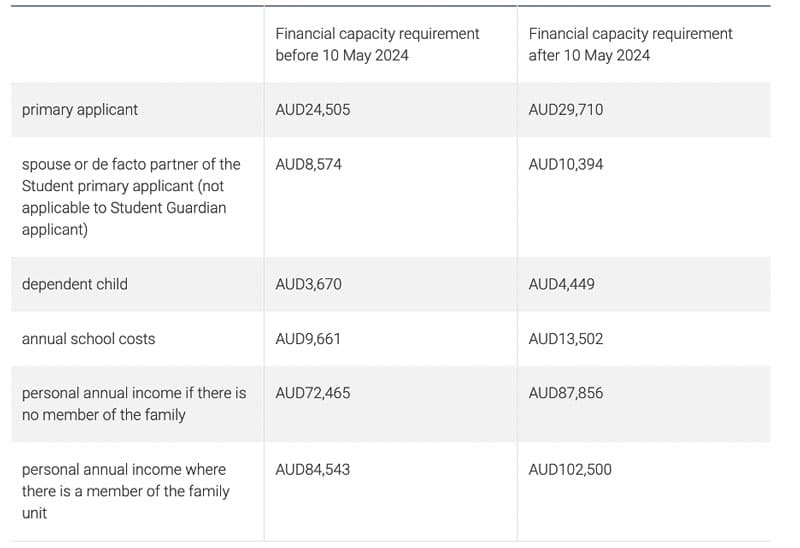Australia increases minimum funds requirements again amid rumoured hike in student visa fees
- Just seven months after increasing the minimum funds requirement for international student visa applications, the Australian government has raised it again according to a formula based on the national minimum wage
- The country’s international education sector is bracing for the possibility that next week’s federal budget will include a significant increase in the fee prospective international students must pay to submit a visa application
- Australian public policy think tank The Grattan Institute circulated a proposal in February 2024 to hike these fees from AUS$710 to AUS$2,500
- UPDATE (15 May 2024): The federal budget was released on 14 May 2024 and did not, after all, include a fee hike but as reported in the Koala News, Phil Honeywood, CEO, International Education Association of Australia, met with ministers after the budget announcement and was told that fees “are likely to go up significantly ‘at a later date.'”
There is less than a week to go until the Australian budget is announced, and many international education stakeholders in the country are worried about what it might include. There is concern that the government is seriously entertaining a proposal the Grattan Institute made in February 2024 to raise international students’ visa application fee from AUS$710 (already higher than the fees in Canada and the US) to AUS$2,500. This more-than-tripling of the fee would remain non-refundable; students who were not approved for a visa would not receive their money back.
While the sector waits to find out if a fee hike will be part of the budget, it is adjusting to the announcement that the government has raised the minimum funds requirement for international students applying for an Australian study visa – the second increase in less than a year. As of 10 May 2024, primary applicants must show funds of at least AUS$29,710 (US$19,537), a 21% increase on the previous amount of AUS$24,505. By comparison, the new requirement is about US$5,000 higher than what students need to show on a Canadian study permit application.
The Australian government says the new minimum funds threshold aligns with a proportion – 75% – of the national minimum wage and that it “will better indicate the amount of money considered reasonable to provide a minimum standard of living while studying in Australia.”

Why would the government consider a visa application increase?
The rationale for significantly raising international students’ visa application fees, as proposed by the Grattan Institute, is that the proceeds from these fees would help to cover an increase in Commonwealth Rent Assistance for poorer Australians who are struggling with high costs of living and accommodation.
Housing, cost of living, and health care are top issues for Australian voters in 2024 and leading into federal election year 2025. While Commonwealth Rent Assistance has been linked to an overall increase in rental prices for those not eligible for it, a top-up to the programme is considered a likely feature of the budget according to political insiders.
The Grattan Institute proposal directly links high international student numbers in Australia to the housing crisis – a claim that has since been debunked by new research. The Grattan Institute likes the “immediate” impact that a fee hike would have in terms of being able to bolster the Commonwealth Rent Assistance fund and considers its impact to be in line with the government’s crackdown on non-genuine students and shady agents and institutions. It favours a fee increase over the idea of a levy:
“A levy [another idea that has been floated] would penalise our top-tier universities that are most attractive to international students, whereas higher student visa application fees would also discourage the growing number of international students who complete cheaper, low-value courses from coming to Australia.”
The Grattan Institute concluded its proposal with this assertion: “Australia’s international education sector delivers huge benefits to Australia, but it also leads to higher rents, hurting vulnerable Australians.”
The damage that could be done
There is little doubt that the optics of an application fee hike are attractive to certain segments of Australians – i.e., those made desperate by affordability issues and politicians on the receiving end of their frustration. But many point out that a massive hike in non-refundable application fees – especially at a time when student visa rejection rates are soaring – would quickly persuade international students to choose alternative destinations.
Abul Rivsi, writing in Independent Australia, disagrees with the Grattan Institute’s assertion that the fee hike would only dissuade students interested in low-value courses in Australia. He believes it will “mean that the best students, who generally have greater choices in where they decide to study, will more likely choose other nations over Australia” and he poses the rhetorical question: “Why risk a non-refundable application fee of $2,500 when the outcome is uncertain?”
Mr Rivsi (a columnist who is also a former Deputy Secretary to the Department of Education) cautions the government against imagining that an application fee would kill two birds with one stone (i.e., discouraging a certain segment of student from applying and providing more rental assistance to poor Australians). Instead, Mr Rivsi recommends “rethinking the overseas student program to make it genuinely focused on attracting only the brightest and best students … it should take note of the recent report of the University Accord to encourage overseas students to study in areas of long-term skill shortage.”
The chief executive of the Independent Tertiary Education Council Australia, Troy Williams, told The Guardian that a fee hike “would be consistent with the Australian government’s clear policy intent to reduce the size of the international education sector.” He says there is a misalignment between Australia’s international education positioning and its immigration policies:
“The former encourages international students to take up study in Australia and the latter seems to say that these students should stay home. There is a real inconsistency there.”
Paul Karp, The Guardian Australia's chief political correspondent, offered this assessment of whether the international student visa fee hike will come to pass in an April 2024 article:
“Demanding more cash for international student visa applications is an incredibly blunt instrument, but for its potential to raise revenue, dampen demand and rebuff [opposition leader] Dutton, it may prove irresistible for Labor.”
The Australian budget will be announced 14 May 2024.
For additional background, please see:
















